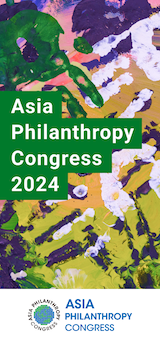Public and private funders around the world are rethinking how best to invest their resources to tackle the world’s most intractable social issues. These so-called ‘wicked problems’ — including climate change, poverty, and pandemics — are often intertwined, have enormous economic and social implications, and involve many competing needs and perspectives. They have no quick or easy solutions and attempts to address them can exacerbate or cause other problems. Funding strategies to tackle such complex issues need to account for these realities.
Such funding strategies, which are not necessarily new, include long-term, flexible support that allows grantees the time and flexibility to identify effective and workable approaches; aid for operating costs to build necessary expertise and capacity; and embracing a longer time horizon for observing impact. Yet these strategies remain notoriously difficult to implement for many grantmakers.
But we believe there’s a window of opportunity for funders to think differently due to increasing interest around the world in collaborative problem-solving approaches that take into account the multifaceted nature of complex societal problems. For example, in this article, we describe how a new global network of funders is exploring how best to support these problem-solving approaches, including with some of the funding models described above. We also share a representative and emerging success story — an Australian foundation piloting long-term flexible funding for an organization trying to navigate access to water in the face of climate change. In describing these efforts, we aim to contribute to discussions about funding practices that work for addressing today’s major social, environmental, and economic challenges.
Support for collaborative problem-solving to tackle complex problems
Collaborative problem-solving efforts prioritize extensive coordination and relationship-building among researchers, community organizations, policymakers, and others. This creates a shared understanding of complex problems by drawing on a wide array of knowledge, evidence, and expertise. Building and sustaining relationships among these partners can add to what is already known, help identify potential and equitable solutions, improve trust in — and uptake of — those solutions, and increase each partners’ capacity to anticipate and react to a problem’s evolving complexity.
The Transforming Evidence Funders Network (TEFN), a group of funders from around the world, is working to develop a funding playbook for these approaches. Critical elements of this emerging playbook include allowing time in a grant to build rapport among partners, supporting the integration of lived experiences with other kinds of knowledge, ensuring flexibility for grantees to navigate uncertainty, and using evaluative measures that account for meaningful relationship-building and other critical outcomes.
In many cases, these efforts also require that funders build the capacity of and support individuals or organizations (e.g., boundary organizations) that are dedicated to facilitating and sustaining these processes. By unpacking their learnings from across issue areas and geographies, TEFN has found that it can leverage bright spots in different sectors to make the case that this new playbook of practices is essential, scalable, and feasible.
A funder’s evolving model
One bright spot comes from the Ian Potter Foundation (IPF), which is expanding support for long-term, flexible funding of at least 10 years. The foundation’s evolution began in 2015 with an extensive internal and external review process to reflect on the foundation’s impact and the needs of its grantees, unearthing some key opportunities for change.
Following this reflection, IPF streamlined its number of focus areas to give program managers more space than they had previously to better understand the scope of problems and deepen their relationships with grantees. At the same time, IPF provided additional open grant rounds across program areas with flexible application deadlines, transparent information about the foundation’s processes for reviewing grant applications, and evaluation support through its research and evaluation team.
An internal analysis by IPF and grantee self-reporting suggests that grantees with core operations and capacity building grants are achieving a higher proportion of — and greater progress toward — their goals than those with IPF’s typical project grants
The foundation also incorporated a wider spectrum of funding mechanisms than it had previously used, with the aim of helping grantees move toward long-term, flexible funding with core or operating funding grants. It developed transparent criteria to guide decisions about where grantees might fit within this new continuum and when they’d be ready to receive multiyear core funding. The criteria include having experienced executives and an engaged board; a clearly defined medium-term strategy; a diversified revenue base or a compelling strategy to achieve one; and evidence of, and ability to, scale impact in their sector.
Within this new funding portfolio, IPF can provide capacity-building grants to prime small or less well-resourced grantees to meet these rigorous benchmarks over time. Staff will also have more time to work closely with grantees, supporting their progress toward receiving operating or core funding grants.
Multiyear funding is now the norm for IPF, with the average funding duration increasing from 13 months in 2015 to more than 40 months in 2022. The foundation also increased its funding for core operations and capacity building, and grantees who receive this new kind of support from IPF are on a promising trajectory. An internal analysis by IPF and grantee self-reporting suggests that grantees with core operations and capacity building grants are achieving a higher proportion of — and greater progress toward — their goals than those with IPF’s typical project grants.
Long-term, flexible funding in practice
A large-scale, $10 million, 10-year grant awarded in 2019 by IPF to establish a new organization, Watertrust Australia Ltd. (WTA), illustrates how the kind of long-term, flexible funding described previously could be used to support organizations tackling complex societal problems. The initiative focused on identifying how to provide consistent and equitable freshwater access while accounting for climate change and the many competing needs in Australia, including the natural environment; metropolitan, rural, regional, and remote communities; Indigenous Australians; and industry. It was clear early on that this task could not be addressed with the simple, short-term project funding that IPF had traditionally supported.
In collaboration with The Myer Foundation and Sidney Myer Fund, IPF commissioned a study in 2017 that indicated a need for collaborative and sustained problem-solving related to freshwater access in which all voices could be heard and valued, as well as for a trusted intermediary to facilitate such a process. Ultimately, 14 Australian philanthropic funders joined IPF and The Myer Foundation to commit $32 million over 10 years to establish WTA, which acts as a boundary organization focused on bringing together the different perspectives on water access in Australia.
The coalition of funders piloted a funding and evaluation structure that maximized flexibility and accountability for WTA — and continues to do so. During the first five years of the grant, the coalition awarded funds unconditionally. Funding for the final five-year tranche is contingent on a successful evaluation by a team of independent evaluators at the five-year grant anniversary. Commissioned by WTA management in conjunction with IPF’s head of research and evaluation and approved by the WTA’s board and reviewed by all funders, the evaluation will now be implemented by WTA. As part of the funding requirements, WTA also developed a 10-year strategy within the first year of the grant and appointed an expert advisory committee to assess progress on the strategic plan. This evaluation structure provides a clear pathway to extended funding that meets the needs of both WTA and the sixteen funders.
Although IPF’s changes to its funding portfolio and the WTA model are promising, more time is needed to understand how these efforts to support long-term, flexible funding will lead to desired outcomes. But even with longer time horizons to observe impact, funders and their evaluator partners will need to use measurement approaches that reflect the specific attributes and potential outcomes of these collaborative approaches. For example, the metrics should indicate whether critical relationship-building is occurring or whether solutions generated are relevant for specific contexts (see the Use of Research Evidence Repository of Methods for potential methodologies).
Even longer-term funding options
We can imagine several options for moving even further, beyond 10 years of funding. For example, a collective of funders could establish a rolling 10-year conditional funding gateway in which all funders agree to an additional commitment for years 11 through 15, provided that the collective effort shows promise at year five. The group could also create endowment structures that set aside a small portion of grant funds and allow boundary organizations to accumulate their own working capital for the longer term.
Time for funding practices that are fit for purpose
We know from our work with TEFN that funders are keen to support more effective approaches for addressing complex societal challenges. That includes supporting collaborative problem-solving processes and boundary organizations that are built to navigate those challenges, such as WTA or others. Beyond the example we describe in this article, there are other emerging efforts to pilot longer-term, flexible funding, such as the National Institutes of Health’s ComPASS program, that are replicable and scalable. So, we encourage other funders to react to this article and share their own stories. While no solution will be perfect, we’re optimistic that funders can rethink and reconfigure funding that is better suited for the complex needs of our times.
Angela Bednarek is the director of The Pew Charitable Trusts’ evidence project, and Craig Connelly is a social investment advisory partner at Perpetual Limited and the former CEO of the Ian Potter Foundation.









Comments (0)